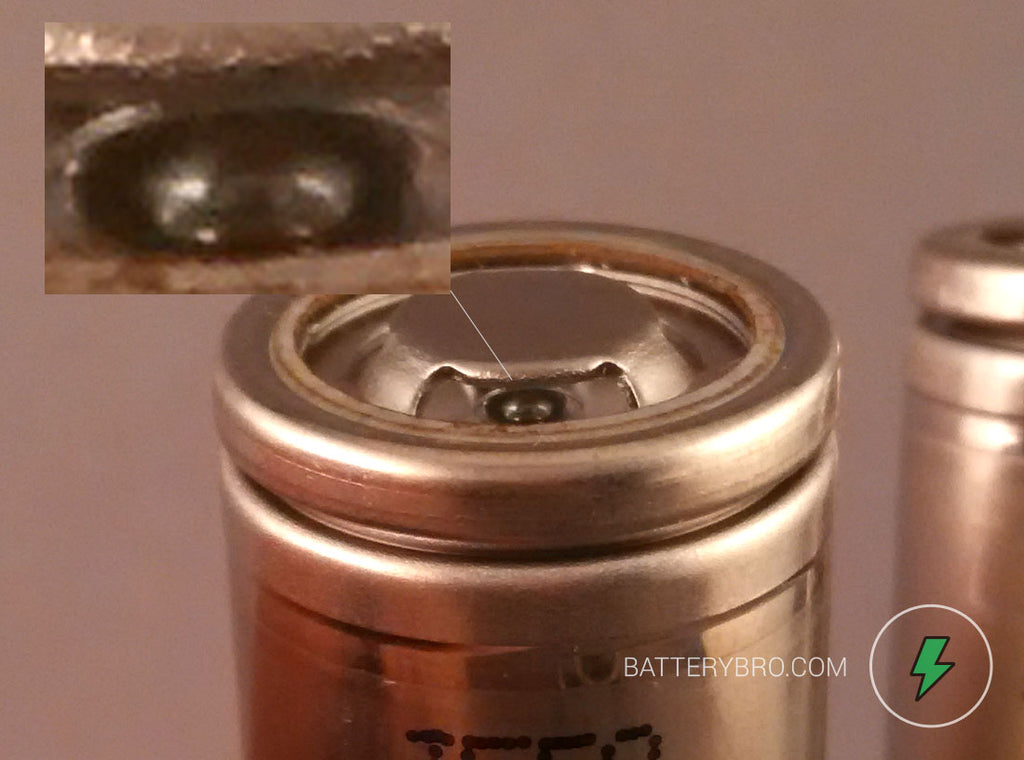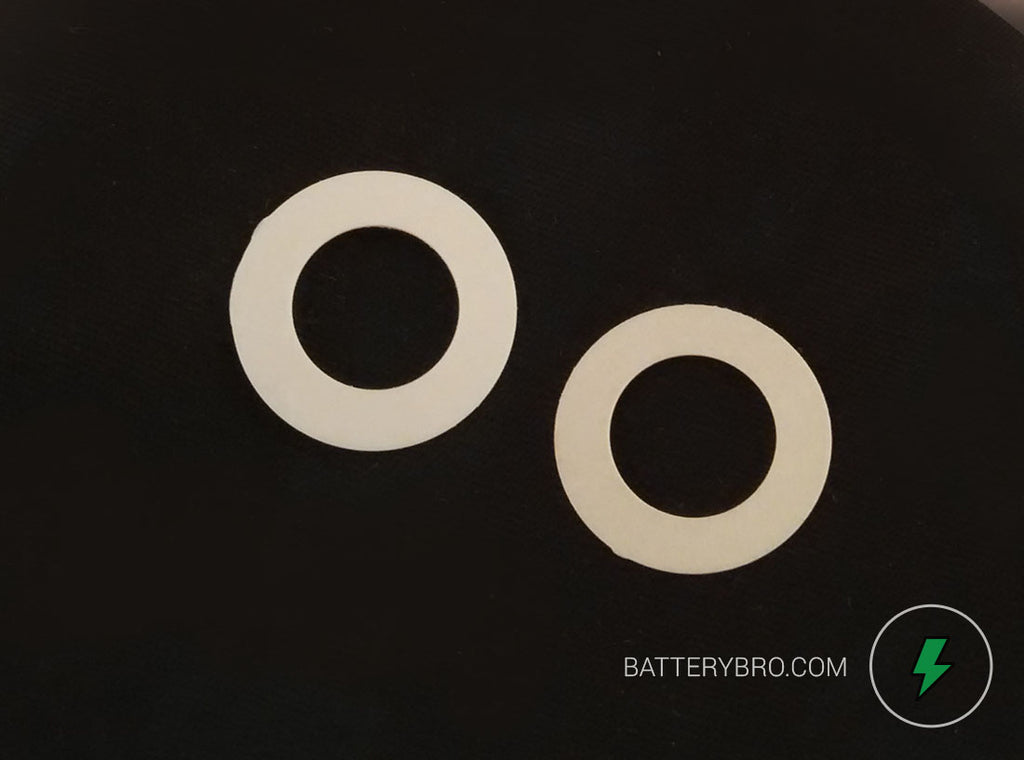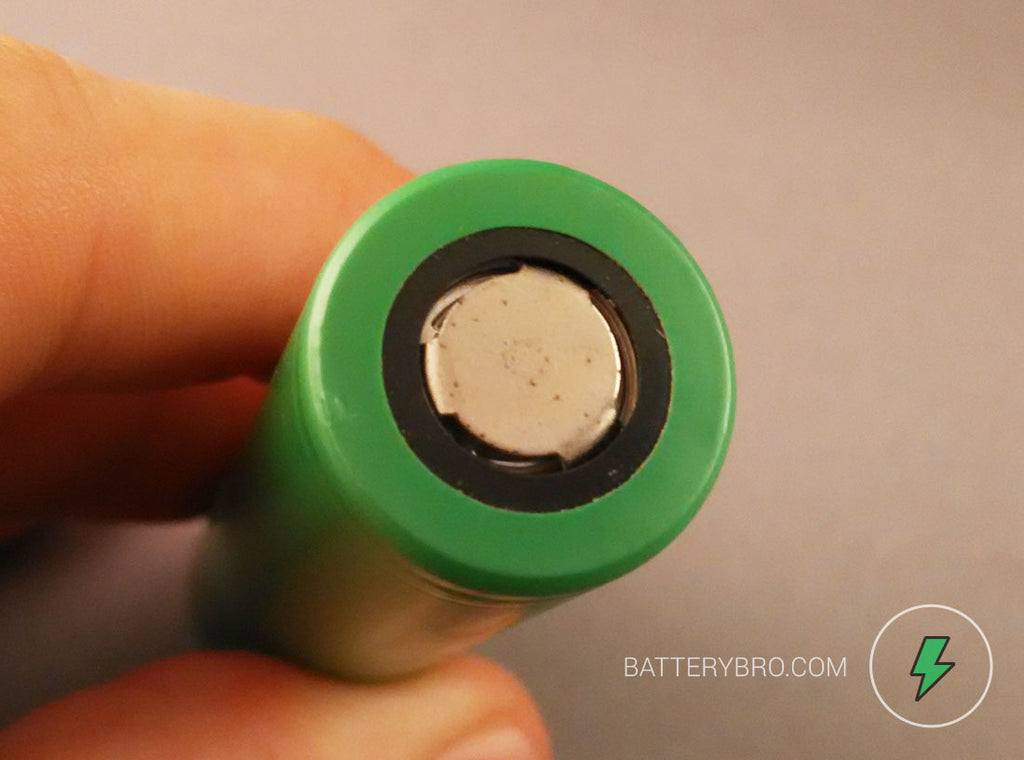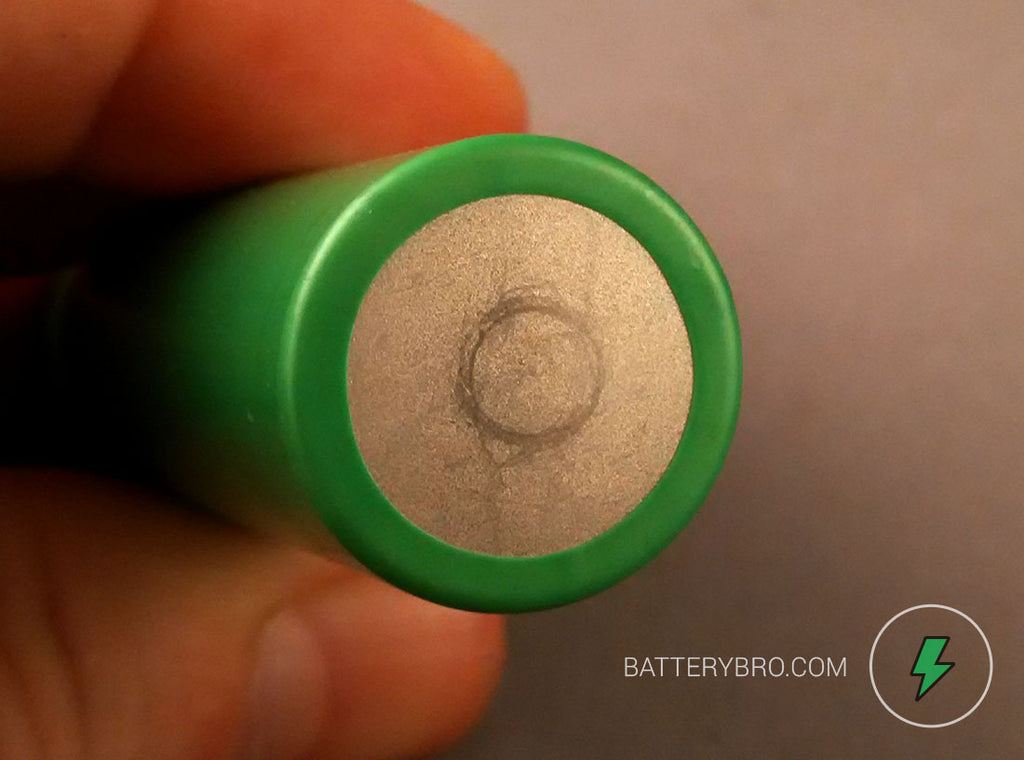Is it a fake 18650 battery? (Featuring the Samsung 25R)

Table of Contents
Likelihood of fakes
Basic Inspection
Likelihood of Fakes
Quickly knowing whether a battery is counterfeit is possible, here I’ll show you how by taking a look at the Samsung 25R.
I picked the Samsung 25R because of its stellar reputation as a great high-amp cell. It finds use in electric cars, power-tools, vaporizers, and more and will almost certainly continue as one of the most popular 18650s at least until late 2015 when a newer generations could gain traction.
You might ask “Are the 25Rs even faked?” It was once thought unlikely because of their availability.
News Story: Houston woman gets a year for selling fake Samsung batteries
(April 2015) A 53 year old Mexican woman named Graciella Balderrama in Houston pleaded guilty and was sentenced to a year in prison for selling counterfeit Samsung batteries on Ebay. She’ll almost certainly be deported after her time in prison and has to pay $90,000 in restitution to Samsung SDI.
The court heard from a Samsung representative who clarified that Samsung takes pride in creating quality products. He noted that Samsung is very concerned anytime counterfeit goods, in breach of its own logo, are introduced to America. Of special concern is when these counterfeit products present a public safety threat like counterfeit lithium-ion batteries do.
And Balderrama participated in a conspiracy. Police have messages of her talking with her contact in China, where she acknowledges understanding the batteries were not genuine but consented to continue working.
Balderrama confessed to authorities she understood the batteries are not genuine Samsung batteries, but she continued to package and offer them as legitimate. Counterfeit lithium-ion batteries really are a public security concern since they cannot follow security regulations. Fake batteries can be dangerous and even explode. This is particularly a growing issue in China where the batteries are created.
Reported here.
So how likely is it that there are fake Samsung batteries on the market? Very likely indeed. Therefore it is vitally important consumers and suppliers are able to tell the difference.
Basic Inspection
Here are the official 25R specifications for your reference:

Using the 25R, let’s start with a visual inspection
The first, easiest thing you can do is a visual inspection. Look at key features of your batteries and compare them to pictures on this blog post. For this blog post I used two 25R cells for each section so we can take a look at the differences between cells. They were bought from two different suppliers.

- Text printed on PVC reads: Line 1: INR18650-25R / Line 2: SAMSUNG SDI. / Line 3: (Different between cells) 2 2E93.
Here are two Samsung 25Rs side-by-side. Do your cells have any noticeable differences? Variations that are safe include slightly different hue for blue than picture (because of different lighting conditions), placement of any printed components (can be offset in both x and y planes). For example the text printed on the PVC is never aligned with the text printed below on the steel.
You may have noticed the text is actually made up of small circles. Counterfeiters may not take care to have exactly the same font and number of circles so sometimes I will count the top-most row of the text’s circles and see if they match. It takes about 20 seconds to count, so for your reference, a genuine 25R has the following number of circles in its top row: [I:3, N:2, R:4, 1:1, 8:3, 6:2, 5:5, 0:3, 2:3, 5:5, R:4].
You should be able to see some kind of printed text on the steel under the blue PVC cover. If you look hard you can see an ‘E3C4’ in the center of the left battery in the image above. The right battery also has a code – see if you can find it. If your battery at home has no faded code underneath the PVC it is likely fake as I have never come across a 25R without them.

Take a close look at your top-caps (positive terminals) and the white washer – there should be no variation between this photo and your battery when looking at the top cap. Important: The Samsung 25R has a very circular positive terminal with three points of connection.

Take a look at the negative terminal of the battery. This is a normal amount of wear on a brand new battery, as the machines which move and test the batteries in the factory often leave scratch marks like these in the center. Beware of unusual amounts of wear and tear.
Make sure that the metal seen is a “silvery” steel color and not “golden” copper. Copper is used as the conductor for nearly all printed circuit boards, including those employed on protected batteries often found with flashlights. If you have a copper negative terminal you also likely have a protected battery that a 3rd party supplier added. You can confirm this by measuring the height of the battery – a protective board can add around 15 mm.
Keeping these contacts clean with a microfiber cloth will help prevent arching.

Besides copper negative terminals, you will also find outdented bottoms on re-wrapped batteries like this Ultrafire with an unknown metal. Original 18650 batteries do not have any protrusion and the 25R is completely flat.
Simple DIY Measurements

For these measurements, you will need some rudimentary tools, like digital calipers and a jewelry scale. So feel free to pass over this section if you don’t have these things at your disposal.

Digital calipers are a cheap way to add an extra bit of evidence when determining authenticity of cells. Manufacturers release data that can be used to confirm authenticity – like the nominal specifications posted above. Width is not the most telling factor, as there is little variation in 18mm 65mm (18650) batteries. However, it takes a small moment so I’ll have a quick check.
IMPORTANT: Do not use metal calipers without putting some electrical tape or other insulator over the ends. I don’t use metal-tipped calipers. If you connect the positive terminal and negative terminal with anything that conducts, you can short-circuit your battery.
The width should be between 18.26 mm and 18.40 mm. My calipers only have an accuracy of .20 mm, the measurement I took was 18.20 mm, so the actual width of my battery matches the nominal size in the manufacturer’s specifications.

Checking out the length, there is more variation here between different batteries. My measurement comes out to 65.30 mm, with a .20 mm error. Nominal specifications require 64.85 mm with a 0.15 mm error. The total error is .35, so my measurement actually falls short by .10 mm even accounting for the error. After realizing this I went back and took the measurements again and made sure to zero the calipers. My actual length measurements now match the nominal manufacturer specifications and everything is fine.

I put a dot on the battery so I don’t mix them up. This is what the first battery weights in at – 43.63 grams.The nominal specs say the 25R should be 45.0g max and nothing else. So the first cell checks out fine.

Here is the weight of the second battery, with nearly no variation from the first it also checks out fine at less than than maximum 45.0g allowed.
Getting naked, taking off the PVC heat-shrink

Markings part one. These markings “J5E8, 48332” and “J5E9, 498B2” can be found one one side of the battery near the top-cap.

When I spin the batteries around I get more markings. Written here is “E3C4” and “IED6, IED6”.
Now I don’t expect your Samsung 25R batteries to match exactly, but if they have these two types of markings on either side it is a nice piece of evidence to add that your batteries are genuine and not fake. I am not sure why the right battery has its code printed twice or that it appears to be darker, but these two factors play no role in determining authenticity apparantly (as each cell was later tested and confirmed to be genuine).

This is the vent of your battery – it spews bad stuff when the battery overheats to relieve pressure. Something mildly interesting about the Samsung 25R is that is has quality control markings right next to the vent, and most batteries do not. Pictured above is a good viewing angle to check out your battery’s vent.

If you get the lighting and angle just right you can actually see the etching marked into the 25R battery near its vent. The other 25R also had a one letter + one number combination. A magnifying glass makes this much easier to do and it can be challenging to find the code especially without removing the white washer and PVC.
I looked at other cells from various manufacturers like the LG HE2 to see if they also have markings near the vent. They do not, and my small search indicates it might be a unique marking to the 25R. So this is a fairly straightforward way to verify your battery as a 25R.

Here is a better look at the battery top-caps with their PVC and washer removed. Aren’t they pretty?

Now this is an interesting feature! Both Samsung 25Rs that I’m testing, once the PVC is removed, are revealed to have a tiny ‘0’ marked into them. As none of the other 18650’s I’ve tested have this marker – it may be an excellent way to quickly identify a genuine 25R from a fake.

A closer look at the symbol, with some “enhancement” so you don’t have to squint. The cross through the circle designates a zero. I do not know if all Samsung 25R cells have this mark, but the two that I tested for this blog post do. You will have to peel back the PVC on the bottom-rim of your battery to do this test. While there is likely little danger in doing this – it is best to completely replace your battery wrap with a new heat-shrink tube afterwards.
I am interested to hear if others also have this 0 marked into the rim of their negative terminal. If you do, please send us a picture or a comment and I’ll attach it to this blog post.

I needed to check that other brands of batteries and other Samsung batteries do not also have this zero etched into them. They do not, and it seems to be a unique characteristic of the Samsung 25R.
Stickers on your battery?
Note that many lithium-ion batteries have a separate sticker on each cell which states the cell’s size, voltage, and capacity. International shipping rules mandated by the United Nations require this information for each cell when shipped via air freight (note: this is not necessary for sea shipping.) Suppliers will print batteries or tape a piece of paper with this information and stick it to the battery. It does not mean the batteries are fake, just that they were shipped via air freight from Asia and the suppliers needed a simple way to comply with the rules.

Here is an example of a couple 25Rs with shipping stickers on them. I found this image on Ebay; you can deduce that the supplier had them shipped via a cargo plane (because ships don’t require the stickers). You can also deduce the supplier bought less than 10,000 cells as this is around the number where shipping by sea becomes necessary.
Other things worth checking out
Top-cap Identification (Top-cap ID Method)

You may have never noticed, but each brand of 18650 has their own specific top-cap which is very difficult to counterfeit. A counterfeiter would need a very cheap way to completely take the battery apart, and put it together again with a low (undetectable) amount of damage. In my experience, this just doesn’t happen and is too difficult. Therefor it is possible to ID an 18650’s manufacturer just by glancing at its top cap.

The lithium-ion battery manufacturers like Samsung, Panasonic, LG, patent absolutely every new idea they have. Licensing technology like the NCR chemistry or other parts of a battery is very profitable so intellectual property protection is important.
It is for this case I suspect each brand of battery has their own particular style of top cap. I do not believe there is any real advantage to any of the designs, and a consumer will never notice a difference. That is, unless they’d like to identify the battery’s brand.
I took about ten batteries of each brand and put them all together in groups to see if I could notice a difference. The difference was obvious immediately, and held up for each group of batteries. So this is a very quick and easy method to see which brand a battery is.

View this image larger on Imgur: http://imgur.com/4gnFl7m
Cells made by LG Chem have four connection points between the positive terminal and body of the top cap. Samsung cells have three. Panasonic cells have more variation and both triangles and three-point contacts were found. As well, many suppliers re-wrap these cells and add a button-top which is seen last. There is also variation in shape of the positive terminal excluding the connection points between being round, straight, or a combination of both.

Maybe you noticed the Samsung and one variation of Panasonic positive terminal were very similar compared to the others. Can you tell the difference between them in the picture above? The correct answer is that the right battery is the Samsung. Check out the small differences, the most notable probably being the dark ring around the circumference of the Panasonic, where the Samsung does not appear to have any such ring. The Panasonic also seems to have a flatter surface near its vent.
Difference between washers

Washers are probably not something you are very interested in. But it adds another piece of reliable evidence to the authentication process. Counterfeiters have a very difficult time being so thorough so it is our edge to have a more complete picture than them.
It is probably true, because of patents, that the washers between manufacturers are also different. I’ve taken an LG HE2 and Samsung 25R washer for comparison above. With the naked eye and discernment of my fingers it was much easier to distinguish differences… the photo does not do a great job at showing the differences.
The left washer is the Samsung 25R – it is brighter, more brittle, and smoother with a glossy finished surface. The LG HE2 washer is slightly browner, without a glossy finish, and is much more elastic and less brittle. The 25R will resist well against bending, and the LG HE2’s washer bends easily like paper. The 25R washer can be pulled apart and snapped quite easily, while the LG washer stretches and is harder to snap apart.
There might be advantages to different washers at high-heat and how they react and help stop thermal-runaway events. But I think that’s really a stretch and likely one does not have any benefit over another. However it is another indicator of authenticity that can be corroborated with the others.

Let’s just measure them before moving on. The hole is about 9 mm in diameter. The 25R’s ring is .30 mm thicker than the LG HE2’s.
Taking a look at batteries under a blacklight
Black lights are pretty cheap and small key-chain lights for identifying fake currency are easy to buy. So half-way while writing this blog post I realized the opportunity and took a walk and bought one. Let’s see if there are any peculiarities while putting a line-up of 18650 batteries under the black light.

Note: The 25R wrapper is not on tightly, as I took this picture after I had already deconstructed the battery somewhat.
The 25R glows brightly when under blacklight, at about the same level of intensity as the other two Samsung batteries. From this I may conclude that Samsung batteries show brightly under blacklight. I can not say exactly how bright without equipment I do not have – but I can compare them to some fake VTC series batteries I was sent as samples from a Chinese supplier. What is interesting is that the fake batteries show a much less saturated reflection of the blacklight, indicating a difference in the chemical composition of the PVC.
If you have a little blacklight key-chain you can check your Samsung 25R PVC. It should be fairly bright, if it gets darker under blacklight it is indicative of a counterfeit cell.
Defects and visual signs of wear and tear
Here are some other ways you can quickly see whether your battery is new or used. There are some obvious defects that a manufacturer would never allow to be sold off to a reputable dealer. If your “new” batteries show any of these signs of wear and tear you have likely purchased used batteries.

The Burn Mark. This battery came with a burn mark that must have been very hot to both scorch the steel and burn away the plastic washer. It was being sold as a new VTC5 but is certainly not. This battery should be recycled.

The rust spots. What is rust doing on your batteries? This is bad news and indicative of a really old battery. Again, this cell was being sold as a new VTC5. If your battery is rusting like this when you buy it, it should be put directly in a nearby recycling bin.

Large amount of bottom scratches. This photo did not do the scratches justice. The entire negative cell was very scratched, in many direction and with scratches reaching the rim of the battery. This is far more damage than the regular wear and tear from a manufacturer’s assembly line. This battery was also being sold as a new Sony VTC5 – but is obviously not.
Samsung 25R discharge tests and voltage noise

Ok so discharge tests are not easy, or quick at all to do and is an exception to the title of this blog post. However I wanted to show you discharge tests quickly to show you what a good clean discharge looks like, and what a dirty discharge looks like. First I charge each battery up to 4.2V with this charger. You can see over 2500 mAh is now held by the battery.

I then use this custom Arduino battery discharge with an 18650 adapter. I have taken countless Samsung 25R discharge tests. I have recorded all kinds of discharge curves and want to give you a quick sense of the curve so you may appreciate voltage symptoms in low-quality or counterfeit 25Rs.

This is what a normal, brand new cell’s discharge looks like. It is not as flat as a high-capacity cell but it is a very flat curve (lithium-ion) for batteries nonetheless.

This is the discharge curve from a Samsung 25R too, but notice the two small blips in voltage. This is indicative of a lower quality cell.

The third is the worst. And this is also the curve of a 25R, albeit with large amount of noise and excessive voltage swings. These voltage dips also caused the final capacity to drop by 100 mAh compared to other tests. If you notice a lot of voltage jumping your battery may be discharging in a similar way.
Summary
Identifying fake batteries (like the Samsung 25R) quickly and easily
As this post is so large, it only makes sense to break it down with some take-away points if you skipped all the details:
- Compare your batteries with pictures on this website
- Measure and weigh the batteries, compare to spec sheet
- Look for faded codes under the PVC
- Look for a two digit code near your 25R’s vent
- Peel back the PVC on the rim of the neg terminal and find the ‘0’
- Use a blacklight and look for a bright reflection
- Look for unusual wear and tear like burns, rust, or excessive scratches
- Look at the top cap, and compare it to the diagram above (shape, connections)
- Look at the negative terminal, make sure it is flat and steel
- Take the PVC off, confirm there are quality control markings
- Take PVC off, and compare washer description with one given above
- Monitor voltage while discharging battery and look for spikes, or jumpy voltage readings
Thanks for reading! Any questions or comments please let me know below.
المصدر batterybro.com

